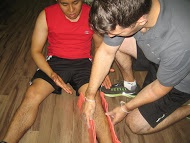
Fractures are some of the most common injuries. A broken bone might be as a result of falls, high impact accidents and during sports that involve physical contact. When this happens, it is important to provide immediate medical care. If ignored, fractures can become worse and may cause irreparable damage to the affected part of the body. In order to help someone who has a broken bone, first it is vital to know what signs and symptoms to look for.
Signs and Symptoms of a Broken Bone
- Swelling is one of the hallmark sings of a broken bone. When fractures occur, the muscles and tissues surrounding the affected born are torn and become sore. As a result, visible signs of swelling might occur. You should also look for bruising on the injured body part. If there is blood on the injured part, then internal bleeding might have occurred.
- The other common symptom of a broken bone is pain. When a bone breaks, nerves may be affected. If the never are pressed, one may feel mild to severe pain. Sometimes though never may be damaged following a fracture, and the victim may not feel any pain but a tingling sensation.
- A bone that protrudes through the skin is an obvious sign of a fracture. Victims may also describe unusual position of a bone after an injury.
First Aid to Treat a Broken Bone
Before applying first aid for a broken bone, first assess the seriousness of the injury. It is important to call for emergency if:
- The physical injury has caused broken bones along with heavy bleeding.
- The limb or affected body part appears to be deformed.
- The broken bone is protruding through the skin.
- The fracture may have occurred in back, neck, hip or pelvis.
- Gentle movement causes severe pain.
Deepening on the type of fracture that one is dealing with, there are different first aid steps to take.
- First, stop any bleeding that may be present. To do this, apply pressure to the wound using a clean cloth or bandage.
- Try as much as possible to restrain the injured victim from moving. If the patient will be moved to a medical facility, apply splints to the injured area, just above and below the fracture sites. Make sure to pad the splints to ease discomfort. Never try to realign or push back a bone that is sticking out if you are untrained.
- If there is pain, apply ice packs to ease discomfort and reduce any swelling that may be present.

